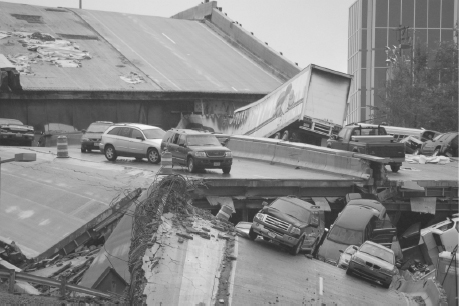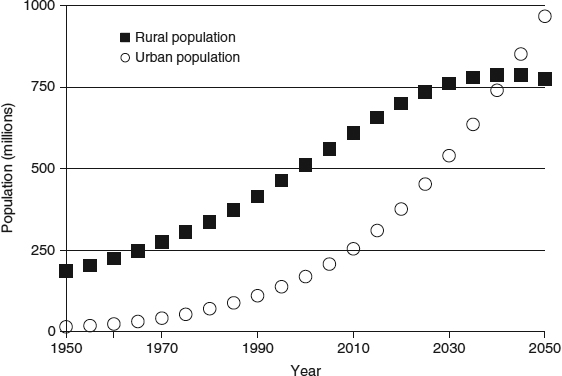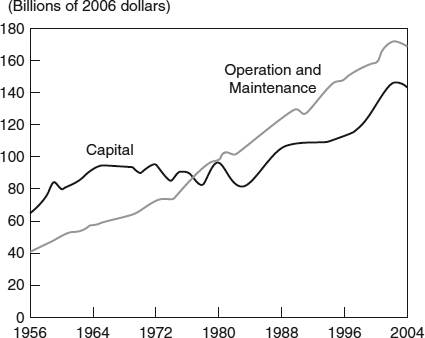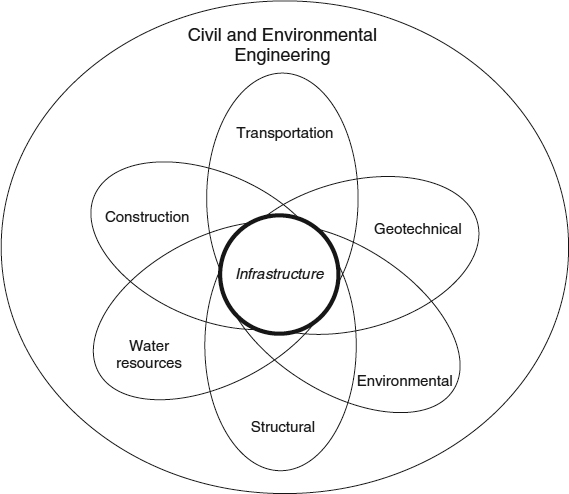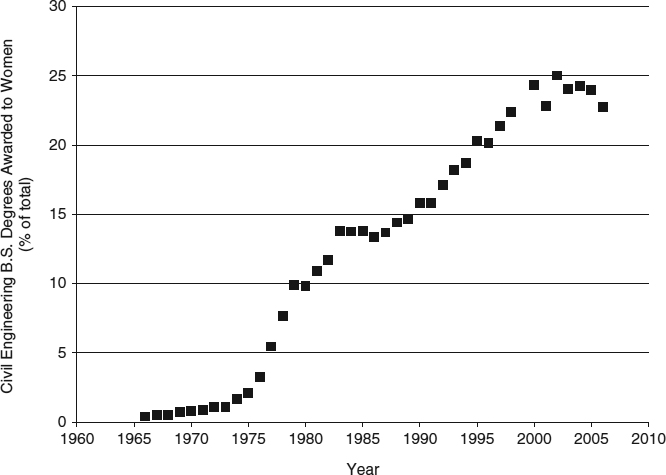Chapter One
Introduction to Infrastructure and Careers in Civil and Environmental Engineering
Chapter Outline
- Introduction
- Introductory Case Study: I-35 W Bridge Collapse
- The Prevalence of Infrastructure
- Infrastructure Systems
- Funding Infrastructure
- Sustainability
- The Civil and Environmental Engineering Professions
- Integration with Other Professions
- Integration with the Public
- Professional Issues
- The Future of Civil and Environmental Engineering
- Employment Opportunities
- About This Book
- Outro
Learning Objectives
After reading this chapter, you should be able to:
- Define infrastructure and explain how it affects nearly all aspects of your life.
- Describe the “infrastructure crisis.”
- Describe the role of civil and environmental engineers in infrastructure management and design.
- Describe the role of each of the subdisciplines of civil engineering.
- Discuss professional issues as they relate to the success of your future career.
Introduction
Infrastructure is defined by Merriam Webster as the underlying foundation or basic framework of an organization or system. As it relates to the work of civil and environmental engineers, infrastructure is the system of public works of a country, state, region, or municipality.

Major infrastructure sectors (termed the built environment) are provided in the following list, with the first nine sectors comprising the civil infrastructure:
Privately-Owned “Public” Works
The term “public works” is commonly used; however, as will be discussed throughout this book, infrastructure components and systems are no longer solely publicly owned. Investment, operation, and ownership of the infrastructure by the private sector is increasing. Electric power supply in the United States has long been provided by a mixture of privately-owned companies and publicly-owned utilities. Today, many sectors of our infrastructure that were traditionally publicly owned now include private ownership (e.g., the Dulles Greenway toll road, more than 15 percent of U.S. drinking water treatment facilities, approximately 50 percent of U.S. landfills).
- Transportation systems (roads, highways, railroads, bridges, tunnels, canals, locks, ports, airports, mass transit, and waterways)
- Structures (including buildings, bridges, dams, and levees)
- Water supply and treatment systems
- Wastewater treatment and conveyance systems
- Solid waste management systems (collection, reuse, recycling, and disposal of wastes)
- Hazardous waste management systems
- Stormwater management systems
- Parks, schools, and other government facilities
- Energy systems (power production, transmission, and distribution)
- Communications systems (telephone, computer, etc.)
This book will focus on the first nine sectors listed above. Although civil and environmental engineers are potentially involved with communications systems (and most certainly rely upon them), the design and maintenance are largely carried out by electrical engineers and technicians. Additionally, civil and environmental engineers are also involved with private sector work. The design, maintenance, and analysis of the private infrastructure are very similar to that of the public infrastructure; for example, designing a parking lot for a “big-box” retail center is similar in many respects to the design of a parking lot for a courthouse.
The natural environment supports all forms of life and all aspects of our built environment. Human health, recreation opportunities, aesthetics, biodiversity, and sustainability depend on clean soil, air, and water, as well as properly functioning ecosystems. We utilize and alter the natural environment for development as well as for transportation and other uses. Also, the raw materials used to construct the built environment originate from the natural environment.
Introductory Case Study: I-35W Bridge Collapse
On August 1, 2007, the I-35W bridge over the Mississippi River in Minneapolis, Minnesota, collapsed carrying rush hour traffic (Figure 1.1). This tragedy resulted in 13 deaths and 145 injuries. The bridge, which carried 140,000 vehicles per day, was replaced and opened for use only 13 months after its collapse, an extraordinarily short length of time for a project of this magnitude.

The events leading up to and following the collapse highlight many aspects of infrastructure engineering and management: design, analysis, maintenance, inspection, emergency response, traffic routing (immediately following the collapse and during reconstruction), planning, and construction, all of which will be discussed in this textbook. The failure of this single infrastructure component had a tremendous impact on regional infrastructure systems (e.g., road, rail, and river transportation.)
Figure 1.1 The Aftermath of the I-35 W Bridge Collapse in 2007.
Source: U.S. Coast Guard/K. Rofidal.
The Minnesota Department of Transportation estimated that the bridge collapse had an impact of $60 million on the economy.
The collapse made national headlines and soon came to symbolize the poor condition of our nation's infrastructure. It helped spur new funding for bridge inspection and maintenance, which is ironic, given that the collapse of the bridge was not primarily due to insufficient maintenance or inspection. Rather, the collapse was due to a design flaw, as determined by the National Transportation Safety Board (NTSB). The NTSB also cited the fact that the bridge had become heavier over time due to modifications, and this additional weight, along with concentrated loads from construction materials, contributed to the collapse.
 NTSB I-35W Bridge Report
NTSB I-35W Bridge Report
The Prevalence of Infrastructure
Consider spending an extended period of time without access to any of the major infrastructure systems. Unless you have survived a catastrophic infrastructure failure or spent time in an underdeveloped nation, you may not appreciate how vital infrastructure is to the quality of life. At a significantly lesser level, we have all had to deal with the inconvenience associated with a temporary loss of services provided by the infrastructure (e.g., a detour resulting from road resurfacing or a water outage caused by nearby underground utility work).
Infrastructure affects nearly every aspect of your daily life. The alarm clock that wakes you in the morning does so thanks to a power grid that supplies electricity to your home or apartment. The shower that provides pressurized water is possible thanks to the underground network of distribution pipes and valves, water storage tanks, and pumps. The fact that this water, along with the water from your bathroom or kitchen faucets, is safe to drink is due to treatment that has occurred at a drinking water treatment facility. When you flush a toilet, the waste is conveniently flushed away and carried in a series of pipes to a wastewater treatment facility where it is extensively treated before being released to the environment. The fact that, for a matter of pennies, your breakfast consists of a banana from South America and a slice of bread made from wheat that was grown perhaps hundreds of miles away is possible thanks to the widespread transportation network of highways, railways, and waterways. Your trip to class, either by foot on a sidewalk, by bike in a bike lane, by mass transit via a bus or light rail system, or in a vehicle on roadways, is possible because of infrastructure.
Labor Strikes
The public sometimes learns “the hard way” just how important a functioning infrastructure is to their quality of life. Strikes by union workers can bring sectors of the infrastructure to a standstill. Recent examples include strikes by workers in London's subway system (the “Tube”) and waste haulers in Seattle, Washington. In 2009, in Toronto, city workers went on strike for more than a month causing a solid waste “nightmare.” Other services were also affected including inspections, permitting, landscape maintenance, and recreation programs.

Modern society depends upon infrastructure. Residential, commercial, and industrial development can be encouraged or discouraged by a municipality through the availability of infrastructure (e.g., roads and water supply). The dramatic population growth of the arid Southwestern United States was largely enabled by massive water supply projects (e.g., Colorado River diversion) to transport water hundreds of miles from sources to users. China's South-to-North Water Diversion Project, to be completed in 2050 at a cost of over $60 billion, will divert 45 billion m3 of river water per year to the arid north for domestic, industrial, and agricultural use. This water will allow new development to occur away from currently overpopulated areas. Such massive projects potentially provide economic growth but can also cause significant social and environmental impacts as will be discussed in later chapters.
Much of the infrastructure we use is invisible to the public due to being buried below ground, or is virtually invisible given that we are so used to seeing it every day. It has been said that, “our infrastructure is like our stomachs—when working properly, we don't even realize it's there.” This is largely true as society often takes the infrastructure for granted. Unfortunately, this often leads to neglect. For example, people assume that the bridges they cross daily will support traffic loads and that safe and abundant water will be supplied from their bathroom faucet. Society also tends to assume that the bridge and the faucet will continue to meet their needs indefinitely with minimal care and attention. And day after day, this is indeed the case. However, infrastructure components and systems do fail, sometimes with catastrophic consequences and always with consequences that have far-reaching effects. Failures can occur for many reasons, such as:
- inadequate design (as in the case of the I-35 W bridge collapse)
- improper construction
- lack of critical maintenance
- unforeseen changes over time in factors affecting performance
- complications caused by another component within the system
- natural disasters
- accidents
- terrorism, vandalism, and war
Dewitt Greer, a former Texas Highway Commissioner, said “We do not have great highways because we are a great nation. We are a great nation because we have great highways.” Larry Roth, former Deputy Executive Director of the American Society of Civil Engineers (ASCE), has aptly suggested that we substitute the term “infrastructure” for “highways” in this quote.
Gross domestic product, or GDP, is the sum value of goods and services produced by a country. Per capita GDP is the GDP divided by the population.
The reason for such a bold assertion will be explained in many ways in this book, but consider briefly the effect of infrastructure on public health and wealth. Dramatic increases in public health (life expectancy has risen from less than 50 years to nearly 80 years since 1900, a 60 percent increase) and in wealth (per capita gross domestic product has increased from approximately $5,000 to $45,000 in inflation-adjusted dollars since 1900, an 800 percent increase) can be directly linked to our infrastructure.
Throughout this textbook, we will often refer to inflation-adjusted dollars because the purchasing power of a dollar varies with time. By adjusting values from different time periods to take into account inflation, they can be directly compared.
The percentage of Americans living in urbanized areas of greater than 50,000 people is steadily increasing and is currently 83 percent. For comparison's sake, the percentage was approximately 40 percent in 1900 and 60 percent in 1950. More than 50 percent of Americans live in large metropolitan areas with populations greater than 1 million. Thus the majority of Americans depend on complex and interdependent infrastructure systems.
Dramatic increases in urban populations are occurring in developing countries around the world as rural residents “flock to the cities” in search of jobs, creating enormous demand for infrastructure that often outpaces its development and often leads to serious public health and social problems. For example, 29 percent of India is urbanized today, but by 2050, this number is expected to grow to 55 percent, corresponding to 900 million people. In comparison, Brazil is currently 86 percent urbanized. The trends for the 50 least developed countries in the world are shown in Figure 1.2.
Figure 1.2 Trends in Urbanization for Least Developed Countries.
Data source: United Nations Department of Economic and Social Affairs, 2009.
Continued prosperity requires infrastructure investment not only to meet increased demands from a growing population, but also to maintain and replace our existing infrastructure. Increased prosperity requires additional investments above and beyond this level.
The Infrastructure Crisis
Civil Engineering magazine, published by ASCE, released a special report in January 2008 titled “The Infrastructure Crisis.”
 The Infrastructure Crisis
The Infrastructure Crisis
Infrastructure Systems
Infrastructure components are integral parts of infrastructure systems. A railway line is part of the rail system, which in turn is part of the larger and more complex transportation system. An individual rail line might meet the needs of the rail system by moving people or goods from point A to point B. However, if an interface with another system, such as an at-grade (i.e., non-elevated) road crossing is not designed appropriately, traffic congestion may result and the road system may fail to meet its objectives.
At a grand scale, the concept of systems is well illustrated by the extensive planning and investment required by a city hosting the Olympics. In 2008, the summer Olympics were hosted by Beijing, China, which received extensive international news coverage of the challenges faced in preparing for the events. The entire infrastructure, with each of its sector systems and subsystems, had to be evaluated to meet a sudden (and importantly, temporary) increase in demand. Lodging, food and supplies, transportation, communications, security, waste disposal, energy, water, and wastewater needs had to be met for the demand created by athletes, delegates, media, and spectators. New structures were constructed for many of these needs while considering potential uses after the Olympics were completed.

Table 1.1 Infrastructure Sector Grades
Source: ASCE, 2009.
In a similar way, large industries and military bases also must be treated as systems. These are often developed in a manner such that they are nearly or entirely “self-contained,” with their own systems of roads, energy, waste handling, water supply, and security.
Funding Infrastructure
Frequently throughout this book, we will refer to ASCE's Report Card for America's Infrastructure, an assessment that is completed periodically to inform the public, engineers, regulators, lawmakers, and other decision-makers as to the condition of our national infrastructure. The 2009 grades for major infrastructure components are provided in Table 1.1.
The average grade for the U.S. infrastructure was a D, and ASCE estimated the funding needs over the next 5 years to be $2.2 trillion. Importantly, this is the amount of money required to raise the overall infrastructure grade to an “acceptable” level (a grade of “B”). The $2.2 trillion far exceeds the estimated $1 trillion currently budgeted. This shortfall in funding will, at best, result in infrastructure functioning at its current level. At worst, the level of performance will decrease.
Low grades notwithstanding, the United States has one of the better infrastructure systems in the world. The World Economic Forum publishes a Global Competiveness Report that ranks nations' economic competiveness based on the quality of legal systems, infrastructure systems, economic stability, higher education, public health, technology, and financial institutions. A summary of the 10 highest ranked nations for five infrastructure categories is presented in Table 1.2. For reference, the rank of the United States in each category is also provided. Germany had the highest overall infrastructure ranking, followed by Hong Kong, France, Singapore, and Switzerland. It is important to note that these rankings are based on scores from surveys of business executives, not engineers. Perhaps engineers' rankings would be similar, but to our knowledge, no such assessment has been completed. Note that the United States fails to rank in the top 10 in any category.
 ASCE's Report Card for America's Infrastructure, 2009
ASCE's Report Card for America's Infrastructure, 2009
Table 1.2 Ranking of World Infrastructure Systems, Top 10 in Each Category and U.S. Rank

Data source: World Economic Forum, 2009.
Figure 1.3 Federal Spending on Infrastructure in the United States.
Source: Congressional Budget Office, 2007.
Federal government spending on infrastructure is illustrated in Figure 1.3, both in inflation-adjusted dollars and as a percent of total spending. The “good news” from this figure is that the inflation-adjusted expenditures have steadily increased. However, according to Figure 1.3, the amount of spending on infrastructure, expressed as a fraction of total spending, has remained relatively steady for the last 20 years (approximately 3 percent), and is significantly less than it was in the 1960s and 1970s. The rapidly developing nations of India and China are investing two to three times this amount as a percent of total expenditures.
 Failure to Act: Economic Impact Report by ASCE
Failure to Act: Economic Impact Report by ASCE
The cost of infrastructure components varies greatly depending on its size and complexity. For perspective, these costs have been summarized in Table 1.3 for various infrastructure components, categorized by order-of-magnitude price ranges.
 Costs of Mega-Projects
Costs of Mega-Projects
One very important concept that will be emphasized throughout this book is the need for funds to not only build infrastructure improvements or replacements (i.e., capital funds), but also funds to operate and maintain projects (i.e., O&M funds). Public funding (i.e., funding by federal, state, and local governments) of these two categories is illustrated in Figure 1.4. Note that since the mid-1970s, O&M expenditures have been greater than capital expenditures. This trend will most likely continue because O&M expenses tend to increase for any individual infrastructure component as it ages and approaches the end of its design life.
Every engineered item, be it an automobile shock absorber or a bridge, is designed to function for a certain length of time, termed design life.
Sustainability
The demand for resources is greater now than ever before in world history. Not only has the world's population doubled since 1950, the amount of resources consumed per person has also increased dramatically. Since resource demand is a function of these two variables (population and per capita consumption), the increase is compounded. For example, world energy consumption has doubled since the mid-1970s. Similarly staggering numbers can be found that quantify recent increases in water consumption, mining activity, waste production, vehicle miles travelled, cropland converted to development, etc. In light of these increases, the need to ensure that sufficient resources are available for future generations is greater than ever. In an increasingly global political and economic environment, we must all be concerned not only with sustainability within the United States, but throughout the world. Motivation to do so may come from a sense of ethical duty or humanitarian desire, or more pragmatically, from security concerns; a lack of resources and political instability in some countries, such as Somalia and Yemen, are contributing factors to the rise of terrorism.
Table 1.3 Range of Construction and Design Costs for Various Infrastructure Components
Figure 1.4 Capital and O&M Spending on Infrastructure in the United States.
Source: Congressional Budget Office, 2007.
The Civil and Environmental Engineering Professions
In the following pages, we will introduce the civil and environmental engineering professions. Once considered a subdiscipline of civil engineering, environmental engineering is now a distinct engineering discipline. For the purposes of this text, we have chosen to combine the two fields as civil and environmental engineering.
Civil and environmental engineers identify, solve, manage, and prevent problems that arise within the construction, environmental, geotechnical, structural, transportation, and water resources subdisciplines of the fields. The interrelationships between these subdisciplines are shown in Figure 1.5, with infrastructure being the focal region of overlap. A primary objective of this textbook is to introduce infrastructure and demonstrate the interrelationships of civil and environmental engineering. Note, however, that within each sub discipline in Figure 1.5, there is a non-infrastructure component (not shown in the figure). This distinction is important in that civil and environmental engineers do not solely work on public infrastructure projects. As an example, structural and environmental engineers may design separate portions of a privately-owned car washing facility. Likewise, structural engineers may design airplane wings and environmental engineers may design industrial treatment processes.
 Collection of More Than 200 Profiles of a Variety of Civil and Environmental Engineering Projects
Collection of More Than 200 Profiles of a Variety of Civil and Environmental Engineering Projects
CONSTRUCTION
Construction engineers design, plan, and manage construction projects. Major focus areas include site layout and earthwork, temporary structures, material quantity and cost estimating, scheduling, quality assurance and control, contracting, bidding, safety, inspection, and personnel management. Note that many engineers with expertise in the other areas of civil and environmental engineering also manage the construction of projects that they and their team design.
 Construction Photo Gallery
Construction Photo Gallery
Figure 1.5 Subdisciplines of Civil and Environmental Engineering, with Infrastructure as the Region of Overlap.
ENVIRONMENTAL
Environmental engineers prevent, minimize, or remediate the contamination of air, soil, water, and the associated human and environmental health aspects of such contamination. Major focus areas include drinking water treatment, water supply, wastewater treatment, surface water quality, air quality, contaminated sites, wetland mitigation, solid and hazardous waste management, and stormwater management. Today, many universities offer degrees in environmental engineering. It is still common, however, to get a degree in civil engineering with an emphasis in environmental engineering.
 Environmental Photo Gallery
Environmental Photo Gallery
GEOTECHNICAL
Geotechnical engineering deals with the behavior of earth materials. Major focus areas include: subsurface sampling and classification; engineering properties (e.g., compressibility, strength) of soils and rock; groundwater seepage; foundations for buildings, bridges, and other structures; earthen structures (e.g., levees, dams); slope stability; retaining walls; and geosynthetics.
 Geotechnical Photo Gallery
Geotechnical Photo Gallery
STRUCTURAL
Structural engineers design and analyze structures to meet safety constraints while considering architectural requirements and aesthetics. Structural engineers must determine the loads that a structure must withstand, the engineering properties of the materials used for construction, the mechanics (i.e., reaction to a load) of the materials, and interaction of structural members (e.g., beams, connections). Major focus areas include buildings, bridges, tunnels, and towers. Structural engineers often work closely with architects to turn the architect's vision into reality.
 Structural Photo Gallery
Structural Photo Gallery
TRANSPORTATION
Transportation engineering deals with the safe and efficient movement of people and goods. Transportation engineers analyze current “traffic” (e.g., pedestrians, automobiles, buses, and ships) and predict future traffic in order to design appropriate systems. Major focus areas include parking, roads, highways, mass transit, airports, shipping ports, and rail.
 Transportation Photo Gallery
Transportation Photo Gallery
WATER RESOURCES
Water resources engineering deals with the quantity, quality, and transport of water. Major focus areas include surface water hydrology, groundwater hydrology, and hydraulics (flow of water in natural or built open channels, and in closed conduits).
 Water Resources Photo Gallery
Water Resources Photo Gallery
The above listed sub disciplines are the major areas of civil and environmental engineering as defined by the National Council of Examiners for Engineering and Surveying (NCEES), which develops professional licensure examinations. ABET, Inc., formerly the Accreditation Board for Engineering and Technology, is the organization responsible for accrediting university programs in engineering and technology, and requires that civil engineering programs provide instruction in at least four of the major subdiscipline areas.
Municipal engineering is not a distinct subdiscipline, but rather a combination of transportation, water resources, and environmental engineering. This term is often used synonymously for civil engineering in a broad sense.
Note that in most of the descriptions of the subdisciplines, the focus was on design (creating a new component or portion thereof) and analysis (studying an existing component). However, civil and environmental engineers are also increasingly responsible, solely or collaboratively, for the research, planning, financing, inspection, construction, start-up, operation, maintenance, security, rehabilitation, inspection, monitoring, and demolition of infrastructure systems and components. Additionally, engineers are responsible for integrating new components into existing systems while meeting economic, social, political, environmental, and ethical constraints. Security is of increasing concern in light of terrorist activity (e.g., the events of 9/11) and natural disasters (e.g., Hurricane Katrina, Japan tsunami/Fukushima nuclear reactor disaster). Additional focus is required to bolster the security and resilience (the ability to “rebound” after a disaster) of our infrastructure systems.
Thus, civil and environmental engineers bear a substantial responsibility for public health and prosperity. The following excerpt is from The Vision for Civil Engineering in 2025 published by ASCE in 2007:
 The Vision for Civil Engineering in 2025
The Vision for Civil Engineering in 2025
Entrusted by society to create a sustainable world and enhance the global quality of life, civil engineers serve competently, collaboratively, and ethically as master:
- planners, designers, constructors, and operators of society's economic and social engine—the built environment;
- stewards of the natural environment and its resources;
- innovators and integrators of ideas and technology across the public, private, and academic sectors;
- managers of risk and uncertainty caused by natural events, accidents, and other threats; and
- leaders in discussions and decisions shaping public environmental and infrastructure policy.
To meet these responsibilities, civil and environmental engineers must be highly trusted professionals.
Integration with Other Professions
Several types of infrastructure can be viewed in the urban setting depicted in Figure 1.6: buildings, lighting, parking, pedestrian walkways, a retaining wall, a bridge, and a waterway. As such, the work of engineers with expertise in several different subdiscipline areas is evident (e.g., construction, structural, transportation, municipal).
No single component of the infrastructure is the domain of a single subdiscipline area, neither is it the domain of civil and environmental engineers only. Rather, various subdiscipline areas of civil and environmental engineering must work together in the design and construction of various components and work with experts from other areas. For example, consider the walkways (one in the foreground and two along the river) in Figure 1.6. Given the setting, the design and construction of the walkways were integrated into other component designs involving structural engineers (bridge), geotechnical engineers (retaining wall), transportation engineers (road), environmental/water resources engineers (river), and construction engineers (installation). Additionally, experts (perhaps engineers, perhaps not) in lighting, safety, aesthetics, urban planning, horticulture, architecture, and other areas were also likely involved in the planning and design. Additional professions with which civil and environmental engineers often work include construction contractors, surveyors, engineering technicians, equipment and material suppliers, maintenance personnel, regulators, public safety personnel (e.g., police, fire), database specialists, and utility representatives.
Figure 1.6 The San Antonio, Texas, Riverwalk.
The most readily apparent challenge in working with different professions is that of different perspectives and priorities. An additional challenge of working with such a diversity of professions is that of vocabulary. Different terms may be used to describe the same thing amongst professions, and in rare occasions, the same term may have two different meanings.
Integration with the Public
More so than those of any other field of engineering, civil and environmental engineering projects involve the public. Citizens are the end users and funders of the vast majority of infrastructure. Also, for many projects, citizens will shape the direction and scope of projects through public meetings. In many cases, citizens will be members of committees that are responsible for approving development plans or reviewing proposals and selecting companies for the design of infrastructure projects. For many engineers, the ability to communicate technical information to non-technical audiences is a formidable challenge. Citizens become extremely frustrated with engineers that cannot speak “their” language. The old advice “know your audience” rings especially true here.
Case in Point: “If You Can't Convince Them, Confuse Them”
The title of this Case in Point is a quotation attributed to President Truman. Although an ethical engineer would never purposely confuse the public, often their use of technical language does just that. Consider this excerpt from the official NTSB press release on the results of the study into the cause of the failure of the I-35 W bridge:
“Shortly after 6 p.m. a lateral instability at the upper end of the L9/U10W diagonal member led to the subsequent failure of the U10 node gusset plates on the center portion of the deck truss. Because the deck truss portion of the I-35 W bridge was considered non-load-path-redundant, the total collapse of the deck truss was unavoidable once the gusset plates at the U10 nodes failed.” (NTSB, 2008b)
News releases are intended for the general public, and apparently the NTSB felt that the general public would understand the terms “lateral instability” and “non-load-path-redundant” as well as understand the significance of the U10 nodes (as compared to the U11 nodes or the P10 nodes, if such nodes even exist).
The Burden and Glory of Engineering Responsibility
“The great liability of the engineer compared to men1 of other professions is that his works are out in the open where all can see them. His acts, step by step, are in hard substance. He cannot bury his mistakes in the grave like the doctors. He cannot argue them into thin air or blame the judge like the lawyers. He cannot, like the architects, cover his failures with trees and vines. He cannot, like the politicians, screen his shortcomings by blaming his opponents and hope the people will forget. The engineer simply cannot deny he did it. If his works do not work, he is damned…. No doubt as years go by the people forget which engineer did it, even if they ever knew. Or some politician puts his name on it. Or they credit it to some promoter who used other people's money.… But the engineer himself looks back at the unending stream of goodness which flows from his successes with satisfactions that few professions may know. And the verdict of his fellow professionals is all the accolade he wants.”—Herbert Hoover, mining/civil engineer and 31st President, 1929–1933.
Source: Herbert Hoover Presidential Library Association.
Professional Issues
LICENSURE
Each state, or jurisdiction such as Washington, DC, has its own requirements for licensure as a professional engineer (PE). A PE license is a requirement for many responsibilities of civil and environmental engineers; thus, obtaining (and maintaining) licensure is encouraged or required by many employers. Typical requirements for becoming a PE include:
Other Resources
 The Year in Infrastructure
The Year in Infrastructure
 Infrastructure 2010: Investment Imperative Report
Infrastructure 2010: Investment Imperative Report
 Infrastructure Blog: “The Infrastructurist”
Infrastructure Blog: “The Infrastructurist”
- Obtain an ABET-accredited baccalaureate degree in engineering
- Pass the Fundamentals of Engineering (FE) examination—a day-long exam, typically taken near the time of graduation, covering basic mathematics and science, engineering fundamentals (statics, mechanics of materials, thermodynamics, engineering economics, etc.), as well as civil and environmental engineering fundamentals
- Complete 4 years of engineering experience under the supervision of a licensed engineer
- Pass the Principles and Practices examination—a day-long exam, taken after meeting items #1 through #3, covering civil and environmental engineering fundamentals and details of a chosen subdiscipline.
We encourage you to pursue licensure as it provides professional stature and creates additional employment opportunities.
Examples of Professional Online Seminars
A recent email from the American Council of Engineering Companies (ACEC) advertised the following online professional development seminars:
- Effective Use of Government Contracts to Optimize Liability Protection
- Bachelor's + Master's or Equivalent: Background and Impact on Architecture/Engineering Firms
- Retirement Plans: Which Is the Best Fit for Your Firm?
- Systematic Client Feedback: How to Get It, Use It, and Benefit From It
- Short-Term Economic Outlook: Will Financial Reform Help Your Business?
- High Speed Rail: Outlook, Opportunities, and Obstacles
The wide array of topics represents the breadth of concerns of engineering companies. Also note that many of these seminars are targeting senior executives.
GRADUATE DEGREES
As the challenges that civil and environmental engineers face become more complex, many entry-level positions now require a master's degree as the minimum level of education. Master's degrees can be solely based on additional course work (typically 30 credits), or on a combination of course work and research. Research assistantships often provide stipends (in the range of $15,000 to $20,000 per year and higher) for living expenses and also cover tuition costs.
In 2006, the NCEES voted to extend the minimum education requirements for licensure to 30 credits of acceptable upper-level undergraduate or graduate coursework beyond the bachelor's degree. This requirement may take effect as early as 2015. The rationale for the requirement includes the following:
- Bachelor's Civil and Environmental Engineering (CEE) degrees today typically require 120 to 130 credits, whereas the requirement several decades ago was 150 credits,
- Other professions (e.g., law and medicine) once required only a bachelor's degree, but now require advanced education, and
- The demands of the engineering profession are increasing such that a bachelor's degree may be inadequate education for professional practice.
The impact of this “requirement” on the engineering profession and its rationale remain a source of debate. It remains the responsibility of the Board of Professional Engineers in each state or jurisdiction to adopt these additional requirements. Notwithstanding, the NCEES vote and its support by ASCE demonstrates significant support for advanced education.
LIFE-LONG LEARNING
Life-long learning (or continuing education as it was once commonly termed) is tremendously important for career development. A bachelor's degree can at best provide the foundation for an engineering career. Life-long learning provides opportunities for growth in specialized technical fields as well as in business and management skills necessary for advancement. It may come in many forms, through employer-directed learning, professional workshops, Internet seminars (“webinars”), and “short courses” (2- or 3-day intensive training). When examining employment opportunities upon graduation, we recommend that you determine the degree to which a potential employer supports life-long learning.
Professional Societies
Just as staying updated on local, national, and international news is important, so is keeping up to date in your professional field. To help you keep updated, each subdiscipline area of civil and environmental engineering has one or more professional societies that act as a forum for discussion, debate, advocacy, and technology transfer. There may be student chapters of several of these organizations at your university, and you are encouraged to consider membership in one or more of them.
Throughout this book we will refer to ASCE (American Society of Civil Engineers), which is considered the “umbrella” organization for civil and environmental engineers and has more than 140,000 members. ASCE also publishes a daily “Smart Brief” on infrastructure. We encourage you to sign up for daily infrastructure e-mail news updates and current events at: http://www.smartbrief.com/asce/.
The Situational Leader
“Effective leaders make things happen. They don't sit around watching other people and waiting to react to whatever situations occur. They know what ought to happen, plan a way to make it happen, and take steps to see that it does!”
—Paul Hersey, author of The Situational Leader
TEAMWORK AND LEADERSHIP
The letters of the word “TEAM” are commonly expanded to the phrase Together Everyone Achieves More. Indeed, the nature of most engineering work is team oriented. ABET mandates that CEE curricula require students to work in teams for course projects. Successful teamwork requires that team members understand:
- team formation and evolution
- personality profiles
- team dynamics
- problem solving
- time management
Moreover, team members must have the ability to foster and integrate a diversity of perspectives, knowledge, and experiences (ASCE, 2008).
Additional skills are necessary for working in multi or cross-disciplinary teams. Such teams are becoming more commonplace, and require collaboration among diverse disciplines (e.g., engineering, economics, and public policy). In such teams, you will need to be able to explain your recommendations and your reasoning to non-engineers, and must understand their viewpoint and appreciate the skills that they bring to the team.
Abraham Lincoln's Leadership Skills
“Among Lincoln's greatest qualities were empowering and trusting his gifted subordinates; communicating brilliantly and understandably to the public; maintaining a determined core of beliefs; running his political party like a master puppeteer; and practicing patience as the nation's leader. He liked to say he was slow to take an important step, but once he did, he never retreated. Lincoln also had sense of humor: He loved to laugh, and his laughter helped America survive its most tragic period.”
—Harold Holzer, historian and author of several books on Lincoln
Reprinted courtesy of American Profile.
Without appropriate leadership, a team, even one composed of effective team members, is unlikely to succeed. Leadership is the ability to accomplish tasks and reach goals through the efforts of other people. Effective companies, organizations, and government agencies are typically led by effective leaders. The converse is equally true, where ineffective leadership leads to only moderate success or leads to the failure of an organization.
There are many definitions of effective leadership, but most definitions include the following traits of leaders:
- honest
- competent
- inspiring
- imaginative/innovative
- dependable
- cooperative
- supportive
- determined
Without leadership, a more suitable expansion of “TEAM” may result: Together Everyone Always Meanders. Certainly, some people are “born leaders,” but by no means does this imply that leadership skills cannot be learned. Gaining leadership skills often requires deliberate intention. These skills will dramatically enhance opportunities for career advancement, and will also provide you with abilities to lead other groups outside of your profession (e.g., volunteer, community, church, and sports.)
Entry-Level Job Responsibilities
Typical entry-level civil engineering jobs have the following responsibilities:
- preparing detailed calculations, specifications, and design drawings
- ensuring conformance with applicable codes and standards
- visiting project sites to inspect construction progress
- compiling data for project reports
- collecting and analyzing field data
- preparing operations and maintenance manuals
- assisting with proposal writing and cost estimating.
Figure 1.7 Percentage of Civil Engineering B.S. Degrees Awarded to Women.
Source: National Science Foundation, 2008.
Senior-Level Job Responsibilities
Typical senior-level (10 to 20 years of experience) positions have the following responsibilities:
- managing project teams
- establishing and managing project priorities
- writing project proposals
- developing and maintaining client relations
- maintaining project quality assurance
- managing regulatory permitting and construction documents
- overseeing project design and specifications
- conducting strategic planning
The Future of Civil and Environmental Engineering
The stereotype of an engineer from previous generations was that of a white male working at a drafting table, wearing thick-rimmed glasses, a white short-sleeved shirt, and a dark, skinny tie. Indeed, the engineering workforce has largely been the domain of white males, which explains the use of the male pronoun solely in the quote by President Hoover in a previous sidebar. However, the demographics of the engineering workforce are changing. For example, the percentage of civil engineering degrees awarded to women has increased from virtually none in the 1960s to more than 20 percent in the past decade (Figure 1.7). The fraction of women in the civil engineering workforce is expected to increase as these new engineers will replace retiring, predominantly male engineers. Similar increases have occurred, and are expected to occur in the future for minorities, who now constitute approximately 9 percent of engineering graduates.
Along with becoming more diverse with respect to race and gender, the engineering field has become more diverse with respect to professional responsibilities. A generation ago, newly hired engineers were typically restricted to design and analysis functions. Today as a young engineer, you can expect to take on many additional tasks such as meeting with clients, presenting at public meetings, writing proposals, and managing construction projects. The responsibilities of future young engineers can be expected to increase even further.
Employment Opportunities
According to the Bureau of Labor Statistics, civil engineering is the largest field of engineering in the United States (Table 1.4). Environmental engineering ranks eighth but is among the fastest growing fields. Employment opportunities in both civil engineering and environmental engineering in the future are favorable, and growth rates are above the average growth rates of many other occupations.
Table 1.4 Distribution of Engineers in the United States by Field, in 2006
| Civil Engineers | 256,000 |
| Mechanical engineers | 227,000 |
| Industrial engineers | 201,000 |
| Electrical engineers | 153,000 |
| Electronics engineers, except computer | 138,000 |
| Aerospace engineers | 90,000 |
| Computer hardware engineers | 79,000 |
| Environmental engineers | 54,000 |
| Chemical engineers | 30,000 |
| Health and safety engineers, except mining safety engineers and inspectors | 25,000 |
| Materials engineers | 22,000 |
| Petroleum engineers | 17,000 |
| Nuclear engineers | 15,000 |
| Biomedical engineers | 14,000 |
| Marine engineers and naval architects | 9,200 |
| Mining and geological engineers, including mining safety engineers | 7,100 |
| Agricultural engineers | 3,100 |
| All other engineers | 170,000 |
Source: Bureau of Labor Statistics, 2009.
About This Book
Traditional engineering education was such that engineering courses dealt exclusively with technical issues. Engineering students were expected to get a holistic education from non-engineering courses in humanities, fine arts, and social sciences. This model proved to be inadequate as the complete separation of the two areas (i.e., engineering from non-engineering) did not provide an opportunity for engineers to place their designs in context. Increasingly, engineering courses include “non-engineering” content. This textbook aims to introduce the first- or second-year engineering student to the “bigger picture” within the context of a potential future career in civil and environmental engineering.
This book is written in a conversational style that we hope you will find very accessible. As such, it breaks with many conventions of engineering communication. For example, the use of “you” (to refer to the reader) and “we” (to refer to the authors) is forbidden in many forms of engineering communication, but we find writing in this style to be more direct and less “academic.”
Also, we have intentionally addressed certain critical topics and applications in more than one chapter. We feel that repeatedly revisiting core topics and demonstrating interconnections will lead to improved comprehension. Conventional textbooks are structured so that each chapter deals with an individual and self-contained set of concepts. While this conventional approach may promote concentration on those concepts, once you have moved on to the next chapter the previous material is often “out of context.” Indeed, the traditional approach to textbooks is analogous to traditional engineering education discussed above, and suffers from similar shortcomings.
Outro
Civil and environmental engineers have made and will continue to make a tremendous impact on public health and prosperity. As students, you are being trained to be future leaders and stewards of the built and natural environments. Future challenges will be great in light of social, economic, environmental, and technological changes. Through collaborative professional, ethical, and sustainable engineering practice, you can indeed make the world a better place.
chapter One Homework Problems
- 1.1 Using the information in Table 1.4, calculate the percentage of engineers that are:
- civil engineers
- environmental engineers
- 1.2 Recreate Figure 1.2 to show the percent of people living in urban areas on the y axis.
- 1.3 What is per capita GDP and why is it potentially a more meaningful value than the GDP of a nation?
- 1.4 In your own words, summarize ASCE's Vision for Civil Engineering in 2025.
- 1.5 Why is the United States experiencing an “infrastructure crisis”?
- 1.6 List the advantages and disadvantages of pursuing a master's degree in civil and/or environmental engineering.
- 1.7 Does ASCE's Vision for Civil Engineering in 2025 apply to the field of environmental engineering? Discuss.
- 1.8 Describe how the responsibilities of entry-level engineers have changed.
- 1.9 Why hasn't the “infrastructure crisis” been resolved?
- 1.10 Which area of emphasis within civil and environmental engineering appeals to you most? Why?
- 1.11 Which area of emphasis within civil and environmental engineering appeals to you least? Why?
- 1.12 Do you think that a master's degree should be required to practice as a professional engineer? Why or why not?
- 1.13 Identify the student chapters of professional civil and environmental engineering societies/organizations at your campus. How would membership in one or more of these organizations benefit students?
- 1.14 Read the “Findings” section of the NTSB Accident Report for the I-35 W bridge collapse (available at www.wiley.com/college/penn). Was the failure of the bridge due to the factors that had caused the bridge to be classified as “structurally deficient?”
- 1.15 Read the “Findings” section of the NTSB Accident Report for the I-35 W bridge collapse (available at www.wiley.com/college/penn). What are some lessons that young engineers can learn from the findings?
- 1.16 Explore a subdiscipline area of civil and environmental engineering. Answer these questions:
- What are some typical careers in this area?
- How essential is a master's degree in this area? Note that in some subdisciplines, a master's degree is more important than in others.
- What is the outlook for jobs in this subdiscipline area?
- What are some specializations within this subdiscipline?
- What are some potential future projects in this area that you find exciting?
- What are some non-infrastructure aspects of this subdiscipline?
- 1.17 Choose a professional journal from ASCE (a list is available at www.wiley.com/college/penn) in an area of interest and prepare a one-page summary of an article published in the last 2 years.
- 1.18 Research a labor strike associated with some sector of the infrastructure, and summarize the effect on society. The example you choose is not to be one of the strikes mentioned in this chapter.
Key Terms
- built environment
- capital funds
- civil infrastructure
- design life
- inflation-adjusted dollars
- infrastructure
- municipal engineering
- natural environment
- operation and maintenance (O&M) funds
- per capita gross domestic product
- public works
References
American Society of Civil Engineers (ASCE). 2007. The Vision for Civil Engineering in 2025. Reston, VA: American Society of Civil Engineers.
American Society of Civil Engineers (ASCE). 2008. Civil Engineering Body of Knowledge for the 21st Century (2nd Edition). Reston, VA: American Society of Civil Engineers.
American Society of Civil Engineers (ASCE). 2009. Report Card for America's Infrastructure. Reston, VA: American Society of Civil Engineers.
Bureau of Labor Statistics. 2009. Occupational Outlook Handbook, 2010-11 edition, Engineers. http://www.bls.gov/oco/ocos027.htm, accessed August 6,2011.
Congressional Budget Office. 2007. Trends in Public Spending on Transportation and Water Infrastructure, 1956 to 2004. Publication No. 2880.
Herbert Hoover Presidential Library Association. West Branch, IA. http://www.hooverassociation.org/hoover/quotes.php, accessed August 6, 2011.
Hersey, P. 1997. The Situational Leader. Escondido, CA: Center for Leadership Studies.
Holzer, Harold. “Abraham Lincoln in Retrospect.” American Profile. http://www.americanprofile.com/articles/abraham lincoln-in-retrospect/, accessed August 6, 2011.
National Science Foundation. 2008. S&E Degrees 1966–2006. NSF 08–321.
National Transportation Safety Board. 2008a. Collapse of 1-35 W Highway Bridge Minneapolis, Minnesota August 1, 2007. NTSB/HAR-08/03 PB2008-916203.
National Transportation Safety Board. 2008b. NTSB Determines Inadequate Load Capacity Due to Design Errors of Gusset Plates Caused 1-35 W Bridge to Collapse. http://www.ntsb.gov/news/2008/081114.html, accessed August 6, 2011.
United Nations, Department of Economic and Social Affairs. World Urbanization Prospects: The 2009 Revision. http://esa.un.org/unpd/wup/, accessed August 6, 2011.
World Economic Forum. 2009. The Global Competiveness Report, 2009–2010. https://members.weforum.org/pdf/GCR09/GCR20092010fullreport.pdf, accessed August 6,2011.

